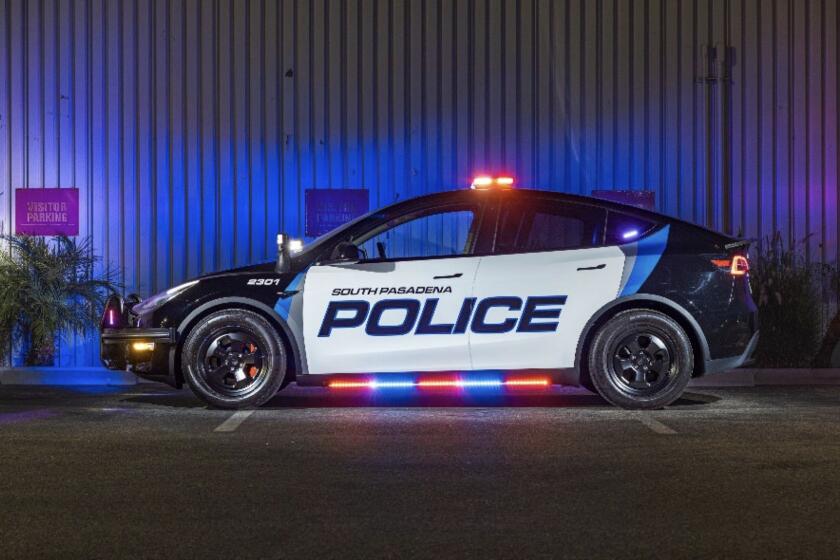Could this be love?
I suppose Acura’s new crossover SUV could be better. It could, for instance, run on recycled Victoria Secret catalogs or the renderings from Star Jones Reynolds’ recent weight-loss program. It could fairly reapportion congressional districts every time you turn the key or make sure Steven Seagal never-never-never makes another blues album.
Short of all that — or having the profile of a Maserati Ghibli — it would be hard to improve upon the Acura RDX, a perfectly constructed, elegantly engineered and shamelessly underpriced (low- to mid-$30,000s) new offering in what is called, in the artful patois of product planning, the “entry premium SUV” segment.
In fact, so smitten am I by this vehicle that I can only conclude I’m exactly the sort of person it was designed for. According to Acura’s psychographic buyer’s profile, I’m apparently what you call an “urban achiever.” I’m edgy, competitive, and I work hard and play hard. During the weekdays I’m entertaining clients and impressing the boss. Weekends I enjoy an active lifestyle of dating, night life and mountain biking.
Right. Just as soon as I can find my pants.
To put the RDX in a box a bit: It is a five-seat, compact crossover utility vehicle — more all-weather than all-terrain — comparable in size to the Toyota RAV4 and the Mazda CX-7. With its plenary array of technological amenities it more than qualifies for the “entry luxury SUV” category, up against the BMW X3, the Lexus RX330 and, soon, the Land Rover LR2.
This burgeoning segment is a kind of dual destination, a genre of vehicle beckoning to people who want to get rid of the luxury trawlers, but don’t want to give up their Bluetooth phones, without which their very ontology would be in doubt. The segment also offers a haven for young affluent urbanites whose lifestyle has outgrown their sedans. I, for one, celebrate the fact that when it arrives next month such people will have a more modest option than the gawdamighty Lincoln Navigator.
What I didn’t expect in the RDX was that it would be such a screaming hoot to drive. With the casually muscular, taut and tuned feel of a proper sport sedan, the RDX rips corners a new one. The steering is quick (2.76 turns lock to lock) with excellent on-center feel and heavy affirmative feedback while cornering.
Once the suspension is compressed in a turn, the car’s behavior is tensed and composed, virtually unflappable over rough pavement. The 4,000-pounder just puts a shoulder down and arcs around. This is the trick, to limit cornering body roll while providing a sufficiently limber suspension to be, well, livable in everyday driving. This trick the RDX does amazingly well.
There is nothing particularly revolutionary about the suspension. It comprises thick-tubed MacPherson struts up front and a multi-link arrangement in the rear, laced together with front and rear stabilizer bars. And yet this thing will corner hard enough to peel an apple.
You can credit the very capable 18-inch tires, or you could give a shout-out to Acura’s Super Handling All-Wheel Drive (SH-AWD). A somewhat simpler version of the system deployed in the Acura RL, the SH-AWD will — if the car’s computers sense an under-steering condition — overdrive the outside rear wheel, helping to steer the car through the turn. According to Acura’s engineers, and I have no reason to doubt it, the RDX corners harder than the BMW X3, yet it has none of that car’s hard and flinty ride.
There are some subtleties worth noting here. The (power-adjustable and heated) leather sports seats help you feel securely situated in the vehicle, which is a major factor in how confident you feel behind the wheel. Also, the seating position is more rakish than in CUVs that perch the seat well about the hood for a high “eye-point,” so it’s not like driving from a bar stool. And you have to love Acura’s compact and thickly padded steering wheel, studded with integral controls.
Needing a potent power plant but not having the room for a naturally aspirated V6 under the hood, Acura instead uses a turbocharged 2.3-liter inline four cylinder, the first turbo engine in the Acura portfolio. To avoid the unrefined, turbo-boosted feel common to such engines, Acura developed a variable-flow turbocharger that keeps the turbo spinning at all times, so the transition to full throttle is seamless.
The motor puts out 240 horsepower and 6,000 rpm, and 260 pound-feet of torque at 4,500 rpm. If there’s a weakness here it is that the torque is still a little soft just off throttle — and the exhaust note, to be sure, could have more cojones. But the thrust picks up quickly as the rpms build. Banging through the standard five-speed automatic, the engine is plenty stout enough to put the RDX across the 60-mph line in about 7.5 seconds.
The transmission offers F1-style paddle shifters behind the steering wheel, so you can downshift quickly for a burst of acceleration. If, after you’ve made the pass, you don’t upshift after a few seconds, the transmission will revert to normal Drive mode, just like the Honda Fit.
Once at cruising speeds, the engine whispers like backstage at Met. Or “The View.”
In the last few years, Acura has made something of a dark art of value. To survey a list of the car’s standard features, you can just imagine rival product planners’ heads exploding. This is a lot of gear for a sub-$40,000 car. To name but a few items: stability control, six air bags, xenon headlights, tire-pressure monitoring, power moon roof, heated outside mirrors with reverse tilt-down, speed-sensitive wipers, leather heated seats, and enough bins, compartments and squirrel holes to carry Rush Limbaugh’s entire personal stash.
The one option is the technology package (about $3,000), which bundles together the navigation system, with best-in-class voice recognition and real-time traffic info; Bluetooth phone connection; and GPS-linked, solar-sensing, dual-zone climate control. Let me unpack that last one for you. The car will monitor its position relative to the sun and compensate for solar heating on one side of the cabin.
And, like the RL, the car comes with an absolutely astonishing sound system, a 410-watt surround-sound unit with DVD-audio capability that will — I noticed on my drive in to work — put you right between the strings of R.E.M.’s mandolin. If there’s a better sound system out there, I’ve yet to hear it.
All of this technology is poured into a beautiful, serenely technical cabin, with a focused and beguilingly contemporary design, rich with an ambient, LED-lighted modernism.
Those praises being sung, no car is so good that one can’t ask for more. One might ask that the RDX didn’t look like a Manga robot with beer goggles on. One might hope for less resemblance to the Subaru B9 Tribeca in the back. Heck, even Subaru wishes the B9 Tribeca didn’t resemble itself.
Here’s another idea: One might wish for better fuel economy. For as much as the RDX accomplishes in splitting the difference between sport sedan and crossover vehicle, it really doesn’t deliver more performance or cargo capacity than a similar sized sport wagon. And yet it returns fairly modest 19/23, city/highway fuel economy.
Why isn’t the RDX available as a hybrid? Oh well. I guess you can’t have everything.
Contact automotive critic Dan Neil at dan.neil@latimes.com.
*
2007 Acura RDX
Base price: $32,000 (estimated)
Price, as tested: $36,800 (estimated)
Powertrain: Turbocharged 2.3-liter, 16-valve DOHC inline four cylinder; five-speed automatic with sequential paddle shift; all-wheel drive
Horsepower: 240 at 6,000 rpm
Torque: 260 pound-feet at 4,500 rpm
Curb weight: 3,924 pounds
0-60 mph: 7.5 seconds
Wheelbase: 104.3 inches
Overall length: 180.7 inches
EPA fuel economy: 19 miles per gallon city, 23 mpg highway
Final thoughts: Turbo-licious






